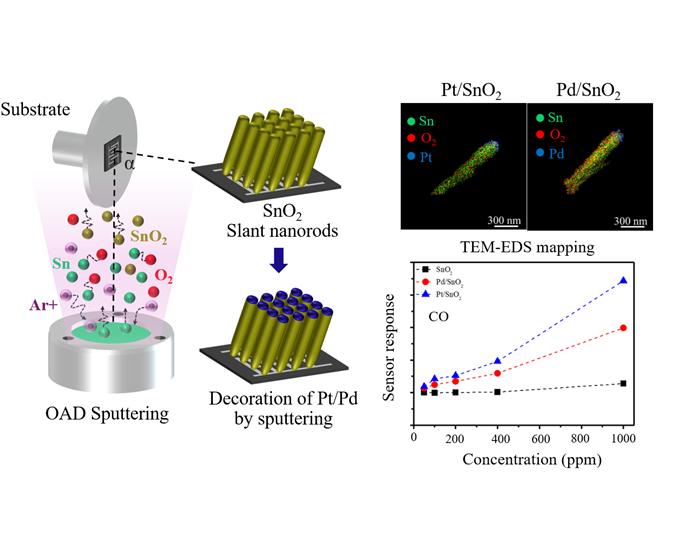The effect of Pt and Pd decoration on SnO\(_{2}\) slant nanorods fabricated using DC magnetron sputtering with OAD technique for CO gas sensing applications
DOI:
https://doi.org/10.55713/jmmm.v35i3.2322Keywords:
SnO2 slant nanorods, Pt Nanoparticles, Pd Nanoparticles, Oblique angle deposition, magnetron sputtering, CO gas sensorAbstract
This research investigates the effect of Pt and Pd decoration on the structure of SnO2 slant nanorods (SNRs) films produced using DC magnetron sputtering with Oblique Angle Deposition (OAD), as well as their impact on the films' physical properties and gas sensing applications. Pt and Pd were deposited onto the SnO2 SNRs for the same duration of 20 s each. Following deposition, all the films were heat-treated temperature at 400℃ for 2 h. The characterization of both as-deposited and annealed films involved analyzing the physical morphology using FE-SEM and the crystal structure using GI-XRD. It was observed that the structure of the SnO2 SNRs showed no significant differences before and after decoration. XRD analysis identified the crystalline structure of SnO2 at the (110), (101), and (211) planes. After decoration, additional peaks corresponding to Pt at (111) and (200) and Pd at (111) were detected. Additionally, TEM mapping revealed that most of the deposited particles were largely concentrated on the top surface of the nanorods. Finally, testing for CO gas sensing performance revealed that the SnO2 SNRs decorated with Pt demonstrated the highest sensitivity, detecting CO gas at concentrations as low as 50 ppm.
Downloads
References
D. Fowler, P. Brimblecombe, J. Burrows, M. R. Heal, P. Grennfelt, D. S. Stevenson, A. Jowett, E. Nemitz, M. Coyle, X. Liu, Y. Chang, G. W. Fuller, M. A. Sutton, Z. Klimont, M. H. Unsworth, and M. Vieno, “A chronology of global air quality,” Philosophical Transactions of the Royal Society A: Mathematical, Physical and Engineering Sciences, vol. 378, no. 2183, p. 20190314, 2020. DOI: https://doi.org/10.1098/rsta.2019.0314
X. Ma, T. Zhang, C. Ji, Y. Zhai, X. Shen, and J. Hong, “Threats to human health and ecosystem: Looking for air-pollution related damage since 1990,” Renewable and Sustainable Energy Reviews, vol. 145, p. 111146, 2021. DOI: https://doi.org/10.1016/j.rser.2021.111146
P. Kumar, A. B. Singh, T. Arora, S. Singh, and R. Singh, “Critical review on emerging health effects associated with the indoor air quality and its sustainable management,” Science of The Total Environment, vol. 872, p. 162163, 2023. DOI: https://doi.org/10.1016/j.scitotenv.2023.162163
D. Y. Nadargi, A. Umar, J. D. Nadargi, S. A. Lokare, S. Akbar, I. S. Mulla, S. S. Suryavanshi, N. L. Bhandari, and M. G. Chaskar, “Gas sensors and factors influencing sensing mechanism with a special focus on MOS sensors,” Journal of Materials Science, vol. 58, no. 2, pp. 559-582, 2023. DOI: https://doi.org/10.1007/s10853-022-08072-0
X. Gao, and T. Zhang, “An overview: Facet-dependent metal oxide semiconductor gas sensors,” Sensors and Actuators B: Chemical, vol. 277, pp. 604-633, 2018. DOI: https://doi.org/10.1016/j.snb.2018.08.129
H. R. Yousefi, B. Hashemi, A. Mirzaei, H. Roshan, and M. H. Sheikhi, “Effect of Ag on the ZnO nanoparticles properties as an ethanol vapor sensor,” Materials Science in Semiconductor Processing, vol. 117, p. 105172, 2020. DOI: https://doi.org/10.1016/j.mssp.2020.105172
M. Hübner, N. Bârsan, and U. Weimar, “Influences of Al, Pd and Pt additives on the conduction mechanism as well as the surface and bulk properties of SnO2 based polycrystalline thick film gas sensors,” Sensors and Actuators B: Chemical, vol. 171-172, pp. 172-180, 2012. DOI: https://doi.org/10.1016/j.snb.2012.02.080
S. Acharyya, and P. Kumar Guha, “Enhanced formaldehyde sensing performance employing plasma-treated hierarchical SnO2 nanosheets through oxygen vacancy modulation,” Applied Surface Science, vol. 655, p. 159640, 2024. DOI: https://doi.org/10.1016/j.apsusc.2024.159640
R. Alrammouz, J. Podlecki, P. Abboud, B. Sorli, and R. Habchi, “A review on flexible gas sensors: From materials to devices,” Sensors and Actuators A: Physical, vol. 284, pp. 209-231, 2018. DOI: https://doi.org/10.1016/j.sna.2018.10.036
J.-H. Kim, A. Mirzaei, H. W. Kim, and S. S. Kim, “Low-voltage-driven sensors based on ZnO nanowires for room-temperature detection of NO2 and CO gases,” ACS Applied Materials & Interfaces, vol. 11, no. 27, pp. 24172-24183, 2019. DOI: https://doi.org/10.1021/acsami.9b07208
M. Horprathum, T. Srichaiyaperk, B. Samransuksamer, A. Wisitsoraat, P. Eiamchai, S. Limwichean, C. Chananonnawathorn, K. Aiempanakit, N. Nuntawong, V. Patthanasettakul, C. Oros, S. Porntheeraphat, P. Songsiriritthigul, H. Nakajima, A. Tuantranont, and P. Chindaudom, “Ultrasensitive hydrogen sensor based on Pt-decorated WO3 nanorods prepared by glancing-angle DC magnetron sputtering,” ACS Applied Materials & Interfaces, vol. 6, no. 24, pp. 22051-22060, 2014. DOI: https://doi.org/10.1021/am505127g
X. Li, L. Fu, H. Karimi-Maleh, F. Chen, and S. Zhao, “Innovations in WO3 gas sensors: Nanostructure engineering, functionalization, and future perspectives,” Heliyon, vol. 10, no. 6, p. e27740, 2024. DOI: https://doi.org/10.1016/j.heliyon.2024.e27740
E. Wongrat, N. Chanlek, C. Chueaiarrom, W. Thupthimchun, B. Samransuksamer, and S. Choopun, “Acetone gas sensors based on ZnO nanostructures decorated with Pt and Nb,” Ceramics International, vol. 43, pp. S557-S566, 2017. DOI: https://doi.org/10.1016/j.ceramint.2017.05.296
M. Bonyani, S. M. Zebarjad, A. Mirzaei, T.-U. Kim, H. W. Kim, and S. S. Kim, “Electrospun ZnO hollow nanofibers gas sensors: An overview,” Journal of Alloys and Compounds, vol. 1001, p. 175201, 2024. DOI: https://doi.org/10.1016/j.jallcom.2024.175201
S. Suriyawong, J. Khumphon, R. Rattanakam, P. Chaopanich, S. Thongmee, S. Youngjan, P. Khemthong, and S. Kityakarn, “Engineering three-dimensionally ordered mesoporous structure of TiO2 for the fast responsive NH3 gas sensor at ambient conditions,” Colloids and Surfaces A: Physicochemical and Engineering Aspects, vol. 666, p. 131281, 2023. DOI: https://doi.org/10.1016/j.colsurfa.2023.131281
G. J. Thangamani and S. K. K. Pasha, “Titanium dioxide (TiO2) nanoparticles reinforced polyvinyl formal (PVF) nanocomposites as chemiresistive gas sensor for sulfur dioxide (SO2) monitoring,” Chemosphere, vol. 275, p. 129960, 2021. DOI: https://doi.org/10.1016/j.chemosphere.2021.129960
C. Oros, M. Horprathum, A. Wisitsoraat, T. Srichaiyaperk, B. Samransuksamer, S. Limwichean, P. Eiamchai, D. Phokharatkul, N. Nuntawong, C. Chananonnawathorn, V. Patthanasettakul, A. Klamchuen, J. Kaewkhao, A. Tuantranont, and P. Chindaudom, “Ultra-sensitive NO2 sensor based on vertically aligned SnO2 nanorods deposited by DC reactive magnetron sputtering with glancing angle deposition technique,” Sensors and Actuators B: Chemical, vol. 223, pp. 936-945, 2016. DOI: https://doi.org/10.1016/j.snb.2015.09.104
X. Tian, Z. Hu, C. Jia, H. Wang, and X. Wei, “A review of advanced gas sensor based on sputtering SnO2 thin film—Challenges and opportunities,” Journal of Environmental Chemical Engineering, vol. 11, no. 6, p. 111516, 2023. DOI: https://doi.org/10.1016/j.jece.2023.111516
Z. Li, W. Zeng, and Q. Li, “SnO2 as a gas sensor in detection of volatile organic compounds: A review,” Sensors and Actuators A: Physical, vol. 346, p. 113845, 2022. DOI: https://doi.org/10.1016/j.sna.2022.113845
Y. Kong, Y. Li, X. Cui, L. Su, D. Ma, T. Lai, L. Yao, X. Xiao, and Y. Wang, “SnO2 nanostructured materials used as gas sensors for the detection of hazardous and flammable gases: A review,” Nano Materials Science, vol. 4, no. 4, pp. 339-350, 2022. DOI: https://doi.org/10.1016/j.nanoms.2021.05.006
G. Domènech-Gil, J. Samà, C. Fàbrega, I. Gràcia, C. Cané, S. Barth, and A. Romano-Rodríguez, “Highly sensitive SnO2 nanowire network gas sensors,” Sensors and Actuators B: Chemical, vol. 383, p. 133545, 2023. DOI: https://doi.org/10.1016/j.snb.2023.133545
X. Kang, N. Deng, Z. Yan, Y. Pan, W. Sun, and Y. Zhang, “Resistive-type VOCs and pollution gases sensor based on SnO2: A review,” Materials Science in Semiconductor Processing, vol. 138, p. 106246, 2022. DOI: https://doi.org/10.1016/j.mssp.2021.106246
H. Zhu, W. Cao, G. K. Larsen, R. Toole, and Y. Zhao, “Tilting angle of nanocolumnar films fabricated by oblique angle deposition,” Journal of Vacuum Science & Technology B, Nanotechnology and Microelectronics: Materials, Processing, Measurement, and Phenomena, vol. 30, no. 3, 2012. DOI: https://doi.org/10.1116/1.4710999
B. Angel, B. Ana, R. G.-E. Agustin, and P. Alberto, “Perspectives on oblique angle deposition of thin films: From fundamentals to devices,” Materials Chemistry and Physics, vol. 76, pp. 59-153, 2016. DOI: https://doi.org/10.1016/j.pmatsci.2015.06.003
C. Patzig, A. Miessler, T. Karabacak, and B. Rauschenbach, “Arbitrarily shaped Si nanostructures by glancing angle ion beam sputter deposition,” Physica Status Solidi (b), vol. 247, no. 6, pp. 1310-1321, 2010. DOI: https://doi.org/10.1002/pssb.200945525
J. Dervaux, P.-A. Cormier, P. Moskovkin, O. Douheret, S. Konstantinidis, R. Lazzaroni, S. Lucas, and R. Snyders, “Synthesis of nanostructured Ti thin films by combining glancing angle deposition and magnetron sputtering: A joint experimental and modeling study,” Thin Solid Films, vol. 636, pp. 644-657, 2017. DOI: https://doi.org/10.1016/j.tsf.2017.06.006
S. Limwichean, N. Kasayapanand, C. Ponchio, H. Nakajima, V. Patthanasettakul, P. Eiamchai, G. Meng, and M. Horprathum, “Morphology-controlled fabrication of nanostructured WO3 thin films by magnetron sputtering with glancing angle deposition for enhanced efficiency photo-electrochemical water splitting,” Ceramics International, vol. 47, no. 24, pp. 34455-34462, 2021. DOI: https://doi.org/10.1016/j.ceramint.2021.08.359
X. Li, H. Zhang, C. Chen, H. Zhang, C. Yang, and X. Ma, “Preparation and mechanism study of ZnO ammonia gas sensor based on precious metal nanoparticles (AuNPs, AgNPs) modification,” Journal of Alloys and Compounds, vol. 1010, p. 177613, 2025. DOI: https://doi.org/10.1016/j.jallcom.2024.177613
J. Dong, J. Guo, T. Shao, H. Kou, Y. Cheng, F. Zhang, X. Liu, and S. Tian, “Enhanced ethanol gas sensing performance of Ag/SnO2 composites,” Sensors and Actuators B: Chemical, vol. 423, p. 136721, 2025. DOI: https://doi.org/10.1016/j.snb.2024.136721
Y. Liu, X. Li, X. Li, C. Shao, C. Han, J. Xin, D. Lu, L. Niu, Y. Tang, and Y. Liu, “Highly permeable WO3/CuWO4 hetero-structure with 3D hierarchical porous structure for high-sensitive room-temperature visible-light driven gas sensor,” Sensors and Actuators B: Chemical, vol. 365, p. 131926, 2022. DOI: https://doi.org/10.1016/j.snb.2022.131926
Y. Tang, Z. Han, Y. Qi, Z. Yang, H. Han, Y. Jiang, X. Zhang, L. Wu, Z. Wang, J. Liu, and F. Wang, “Enhanced ppb-level formaldehyde sensing performance over Pt deposited SnO2 nanospheres,” Journal of Alloys and Compounds, vol. 899, p. 163230, 2022. DOI: https://doi.org/10.1016/j.jallcom.2021.163230
W. Liu, X. Si, Z. Chen, L. Xu, J. Guo, L. Wei, G. Cheng, and Z. Du, “Fabrication of a humidity-resistant formaldehyde gas sensor through layering a molecular sieve on 3D ordered macro-porous SnO2 decorated with Au nanoparticles,” Journal of Alloys and Compounds, vol. 919, p. 165788, 2022. DOI: https://doi.org/10.1016/j.jallcom.2022.165788
C. Liu, Q. Kuang, Z. Xie, and L. Zheng, “The effect of noble metal (Au, Pd and Pt) nanoparticles on the gas sensing performance of SnO2-based sensors: a case study on the {221} high-index faceted SnO2 octahedra,” CrystEngComm, vol. 17, no. 33, pp. 6308-6313, 2015. DOI: https://doi.org/10.1039/C5CE01162K
S. Limwichean, P. Eiamchai, C. Ponchio, N. Kasayapanand, and M. Horprathum, “Comparative investigations of DCMS/HiPIMS reactively sputtered WO3 thin films for photo-electro-chemical efficiency enhancements,” Vacuum, vol. 185, p. 109978, 2021. DOI: https://doi.org/10.1016/j.vacuum.2020.109978
T. Hyodo, T. Goto, M. Takamori, T. Ueda, and Y. Shimizu, “Effects of Pt loading onto SnO2 electrodes on CO-sensing properties and mechanism of potentiometric gas sensors utilizing an anion-conducting polymer electrolyte,” Sensors and Actuators B: Chemical, vol. 300, 2019. DOI: https://doi.org/10.1016/j.snb.2019.127041
Ö. Şahin, A. Akdağ, S. Horoz, and A. Ekinci, “Physical and electrochemical effect of bimetallic Pd–Mo nanoalloys supported on Vulcan XC-72R carbon as cathode catalysts for proton exchange membrane fuel cell,” Electrocatalysis, vol. 14, no. 2, pp. 202-212, 2023. DOI: https://doi.org/10.1007/s12678-022-00787-7
H. Ren, S. Tao, H. Pan, J. Huang, and S. W. Joo, “Template preparation of porous Pt-modified SnO2 microflowers for high-response detection of VOCs,” Materials Research Bulletin, vol. 170, 2024. DOI: https://doi.org/10.1016/j.materresbull.2023.112601
R. Lotfi Orimi, and M. Maghouli, “Optical characterization of SnO2 nanostructure thin films, annealed at different temperatures,” Optik, vol. 127, no. 1, pp. 263-266, 2016. DOI: https://doi.org/10.1016/j.ijleo.2015.10.033
N. Zingwe, E. Meyer, and J. Mbese, “Evaluating the efficacy of binary palladium alloy PdO-Pd for use as an electrocatalyst in DSSC counter electrodes,” South African Journal of Chemical Engineering, vol. 37, pp. 92-97, 2021. DOI: https://doi.org/10.1016/j.sajce.2021.05.002
B. Samransuksamer, T. Jutarosaga, M. Horprathum, A. Wisitsoraat, P. Eiamchai, S. Limwichean, V. Patthanasettakul, C. Chananonnawathorn, and P. Chindaudom “Highly sensitive H2 sensors based on Pd- and PdO-decorated TiO2 thin films at low-temperature operation,” Key Engineering Materials, vol. 675-676, pp. 277-280, 2016. DOI: https://doi.org/10.4028/www.scientific.net/KEM.675-676.277
H. H. Kan, and J. F. Weaver, “Mechanism of PdO thin film formation during the oxidation of Pd (111),” Surface Science, vol. 603, no. 17, pp. 2671-2682, 2009. DOI: https://doi.org/10.1016/j.susc.2009.06.023
C. Ke, W. Zhu, J. S. Pan, and Z. Yang, “Annealing temperature dependent oxygen vacancy behavior in SnO2 thin films fabricated by pulsed laser deposition,” Current Applied Physics, vol. 11, no. 3, pp. S306-S309, 2011. DOI: https://doi.org/10.1016/j.cap.2010.11.067
Q. Wang, C. Wang, H. Sun, P. Sun, Y. Wang, J. Lin, and G. Lu, “Microwave assisted synthesis of hierarchical Pd/SnO2 nano-structures for CO gas sensor,” Sensors and Actuators B: Chemical, vol. 222, pp. 257-263, 2016. DOI: https://doi.org/10.1016/j.snb.2015.07.115
Q. Wang, L. Bao, Z. Cao, C. Li, X. Li, F. Liu, P. Sun, and G. Lu, “Microwave-assisted hydrothermal synthesis of Pt/SnO2 gas sensor for CO detection,” Chinese Chemical Letters, vol. 31, no. 8, pp. 2029-2032, 2020. DOI: https://doi.org/10.1016/j.cclet.2019.12.007
S. Peng, P. Hong, Y. Li, X. Xing, Y. Yang, Z. Wang, T. Zou, and Y. Wang, “Pt decorated SnO2 nanoparticles for high response CO gas sensor under the low operating temperature,” Journal of Materials Science: Materials in Electronics, vol. 30, no. 4, pp. 3921-3932, 2019. DOI: https://doi.org/10.1007/s10854-019-00677-7
A. Gurlo, “Interplay between O2 and SnO2: Oxygen ionosorption and spectroscopic evidence for adsorbed oxygen,” ChemPhysChem, vol. 7, no. 10, pp. 2041-2052, 2006. DOI: https://doi.org/10.1002/cphc.200600292
A. K. Gangwar, R. Godiwal, S. Srivastava, P. Pal, G. Gupta, and P. Singh, “Preparation of nanocrystalline Pd/SnO2 thin films deposited on alumina substrate by reactive magnetron sputtering for efficient CO gas sensing,” Materials Research Bulletin, vol. 148, p. 111692, 2022. DOI: https://doi.org/10.1016/j.materresbull.2021.111692
M. H. Saberi, Y. Mortazavi, and A. A. Khodadadi, “Dual selective Pt/SnO2 sensor to CO and propane in exhaust gases of gasoline engines using Pt/LaFeO3 filter,” Sensors and Actuators B: Chemical, vol. 206, pp. 617-623, 2015. DOI: https://doi.org/10.1016/j.snb.2014.10.007
K. C. Lee, Y. J. Chiang, Y. C. Lin, and F. M. Pan, “Effects of PdO decoration on the sensing behavior of SnO2 toward carbon monoxide,” Sensors and Actuators B: Chemical, vol. 226, pp. 457-464, 2016. DOI: https://doi.org/10.1016/j.snb.2015.12.011
S. Ghosh, M. Narjinary, A. Sen, R. Bandyopadhyay, and S. Roy, “Fast detection of low concentration carbon monoxide using calcium-loaded tin oxide sensors,” Sensors and Actuators B: Chemical, vol. 203, pp. 490-496, 2014. DOI: https://doi.org/10.1016/j.snb.2014.06.111
D. T. Do, N. D. Hoa, P. V. Tong, N. V. Duy, T. D. Dao, H. V. Chung, T. Nagao, and N. V. Hieu, “Effective decoration of Pd nanoparticles on the surface of SnO2 nanowires for enhancement of CO gas-sensing performance,” Journal of Hazardous Materials, vol. 265, pp. 124-132, 2014. DOI: https://doi.org/10.1016/j.jhazmat.2013.11.054
Y. C. Lee, H. Huang, O. K. Tan, and M. S. Tse, “Semiconductor gas sensor based on Pd-doped SnO2 nanorod thin films,” Sensors and Actuators B: Chemical, vol. 132, pp. 239-242, 2008. DOI: https://doi.org/10.1016/j.snb.2008.01.028
C. Liewhiran, N. Tamaekong, A. Wisitsoraat, A. Tuantranont, and S. Phanichphant, “Ultra-sensitive H₂ sensors based on flame-spray-made Pd-loaded SnO2 sensing films,” Sensors and Actuators B: Chemical, vol. 176, pp. 893-905, 2013. DOI: https://doi.org/10.1016/j.snb.2012.10.087
Z. Wang, Z. Li, T. Jiang, X. Xu, and C. Wang, “Ultrasensitive hydrogen sensor based on Pd(0)-loaded SnO2 electrospun nano-fibers at room temperature,” ACS Applied Materials & Interfaces, vol. 5, no. 6, pp. 2013-2021, 2013. DOI: https://doi.org/10.1021/am3028553
S. Das, D. Sarkar, and D. Basak, “Pt nanoparticles decorated SnO2 nanoneedles for efficient CO gas sensing applications,” Sensors and Actuators B: Chemical, vol. 256, pp. 656-664, 2018. DOI: https://doi.org/10.1016/j.snb.2017.09.206

Downloads
Published
How to Cite
License
Copyright (c) 2025 Journal of Metals, Materials and Minerals

This work is licensed under a Creative Commons Attribution-NonCommercial-NoDerivatives 4.0 International License.
Authors who publish in this journal agree to the following terms:
- Authors retain copyright and grant the journal right of first publication with the work simultaneously licensed under a Creative Commons Attribution License that allows others to share the work with an acknowledgment of the work's authorship and initial publication in this journal.
- Authors are able to enter into separate, additional contractual arrangements for the non-exclusive distribution of the journal's published version of the work (e.g., post it to an institutional repository or publish it in a book), with an acknowledgment of its initial publication in this journal.












